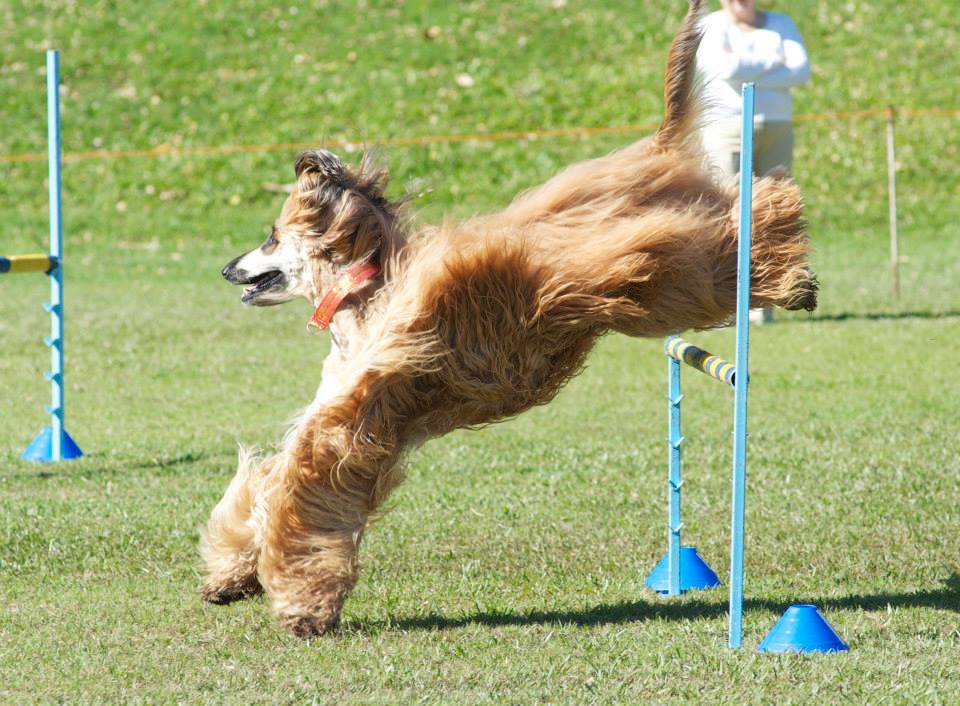
At Jimboomba we offer agility classes for beginners to competition level. This
fast paced, enjoyable sport has become very popular in recent years and is great
for fitness, fun and building the human – canine bond.
Agility FAQs – thanks to Wikipedia
What is dog agility?
Agility is a dog sport in which a handler directs a dog through
an obstacle course in a race for both time and accuracy. Dogs run off-lead with no food
or toys as incentives, and the handler can touch neither dog nor obstacles. The
handler’s controls are limited to voice, movement, and various body signals,
requiring exceptional training of the animal and coordination of the handler.
What is an agility course?
In its simplest form, an agility course consists of a set of standard obstacles,
laid out by an agility judge in a design of his or her own choosing on a roughly
30 by 30 metre outdoor area. Numbers indicate the order in which the dog must
complete the obstacles.
How does an agility competition work?
Because each course is different, handlers are allowed a short walk-through
before the competition starts. During this time, all handlers competing in a
particular class can walk or run around the course without their dogs,
determining how they can best position themselves and guide their dogs to get
the most accurate and rapid path around the numbered obstacles. The handler
tends to run a path much different from the dog’s path,
Printed maps of the agility course, called course
maps, are often made available to the handlers before they run, to help the
handlers plan their course strategy. The course map contains icons indicating
the position and orientation of all the obstacles, and numbers indicating the
order in which the obstacles are to be taken. Course maps were originally drawn
by hand, but nowadays almost all course maps are created using a program called Clean
Run Course Designer.
Each dog and handler team gets one opportunity together to attempt to complete
the course successfully. The dog begins behind a starting line and, when
instructed by his handler, proceeds around the course. The handler typically
runs near the dog, directing the dog with spoken commands and with body language
(the position of arms, shoulders, and feet).
Because speed counts as much as accuracy, especially at higher levels of
competition, this all takes place at a full-out run on the dog’s part and, in
places, on the handler’s part as well.
Scoring of runs is based on how many faults are
incurred. Penalties can include not only course
faults, such as knocking down a bar in a jump, but also time
faults, which are the number of seconds over the calculated standard
course time, which in turn is determined based on the competition level,
the complexity of the course, and other factors.
How do I begin agility training?
Dogs can begin training for agility at any age; however, care is taken when
training dogs under a year old so as to not harm their developing joints.Dogs
generally start training on simplified, smaller, or lowered (in height) agility
equipment and training aids (such as ladders and wobbling boards to train
careful footing);however, even quickly learning puppies must be finished growing
before training on equipment at standard height to prevent injury.
Introducing a new dog to the agility obstacles varies in response. Each
individual dog learns at his own pace; confident dogs may charge over equipment
with little encouragement, while more timid dogs may take weeks to overcome
their hesitations with much encouragement.
Common reasons for joining an agility class include:
- Access to agility equipment
- Seeking the guidance and expertise of instructors .
- Training in a more distracting environment, which is helpful in preparation for competition.
What agility classes are offered at Jimboomba?
1 Foundation Course – For beginners
For beginners – this class provides the essential grounding for future agility
exercises and introduces a number of core behaviours that are essential for safe
and effective agility handling.
2 Equipment –
For Foundation Class graduates – this class leads on from basic skills and
introduces the core obstacles in a controlled environment.
3 Pre Trialler – 6.3pm for 7:00pm start
Following on from equipment, handlers build and navigate basic courses to
beginning competition level
4 Trialing – 6.3pm for 7:00pm start
For people who are trialing to practice and to improve their performance over different course set ups
How do I enrol in Jimboomba agility classes?
Contact Jacqui fixit@iimetro.com.au
Foundation and Equipment classes are offered periodically and places fill fast,
so book early to avoid disappointment.
